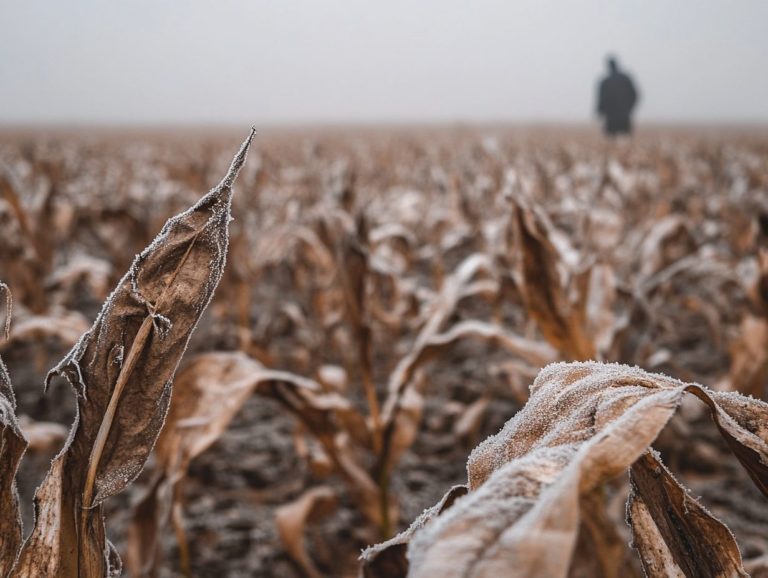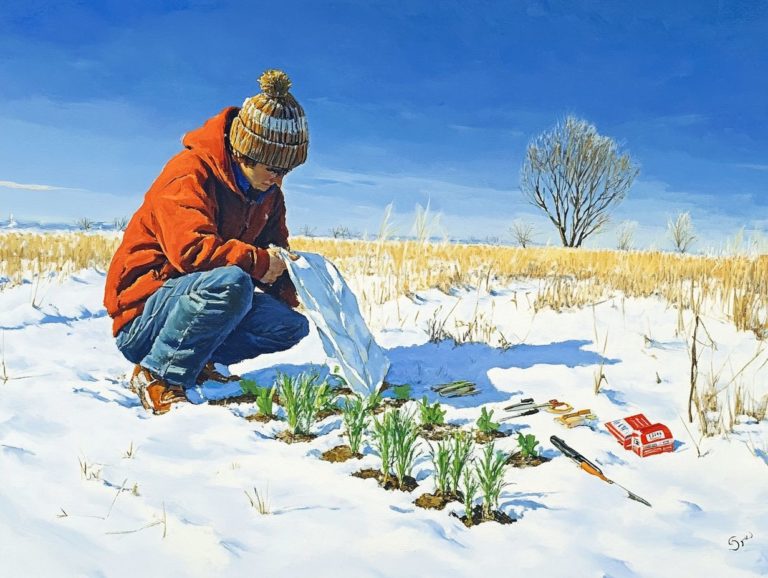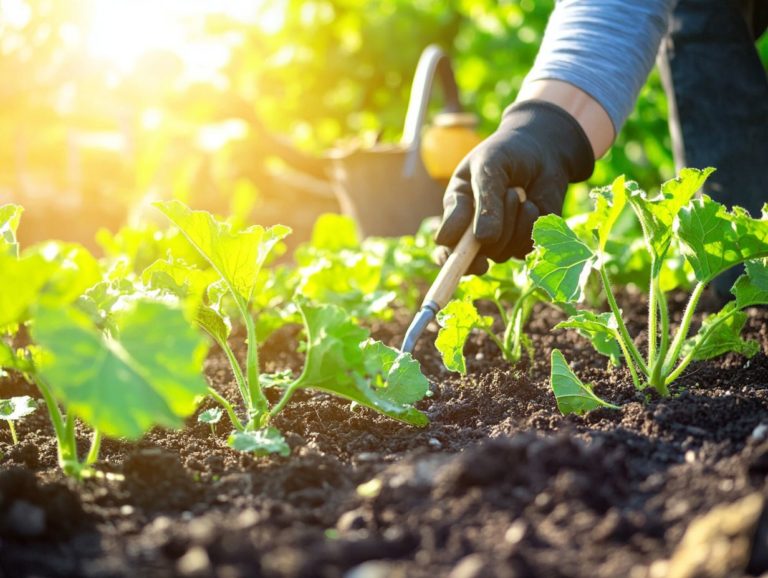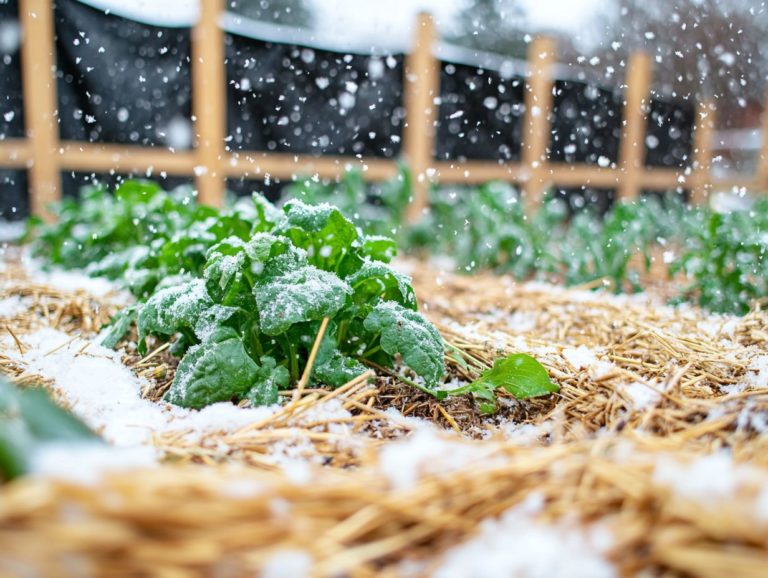Growing Lettuce in Cold Conditions: A Guide
Growing lettuce in cold conditions might appear daunting. Yet, with the right varieties and techniques, you can achieve a bountiful harvest, even when the temperatures drop. This guide will help you unlock the secrets to successful lettuce growing, including selecting the best lettuce that can survive cold weather, preparing your soil for optimal growth, and employing effective planting and care strategies.
This guide also offers essential tips for safeguarding your crops from pest problems and frost, ensuring a successful lettuce harvest. Don’t miss out on enjoying fresh salad greens during winter!
Dive in and discover how to elevate your outdoor gardening and cold-weather gardening experience to new heights.
Contents
- Key Takeaways:
- Why Grow Lettuce in Cold Conditions?
- Choosing the Right Lettuce Varieties
- Preparing the Soil for Cold Weather Lettuce
- Planting and Caring for Lettuce in Cold Weather
- Protecting Lettuce from Frost and Other Cold Weather Threats
- Harvesting and Storing Cold Weather Lettuce
- Frequently Asked Questions
- 1. What are the best conditions for growing lettuce in cold weather?
- 2. What type of lettuce is best for growing in cold conditions?
- 3. How do I prepare my soil for growing lettuce in cold conditions?
- 4. Can I grow lettuce in containers in cold weather?
- 5. How often should I water my lettuce plants in cold weather?
- 6. Are there any tips for protecting my lettuce plants from cold weather?
Key Takeaways:
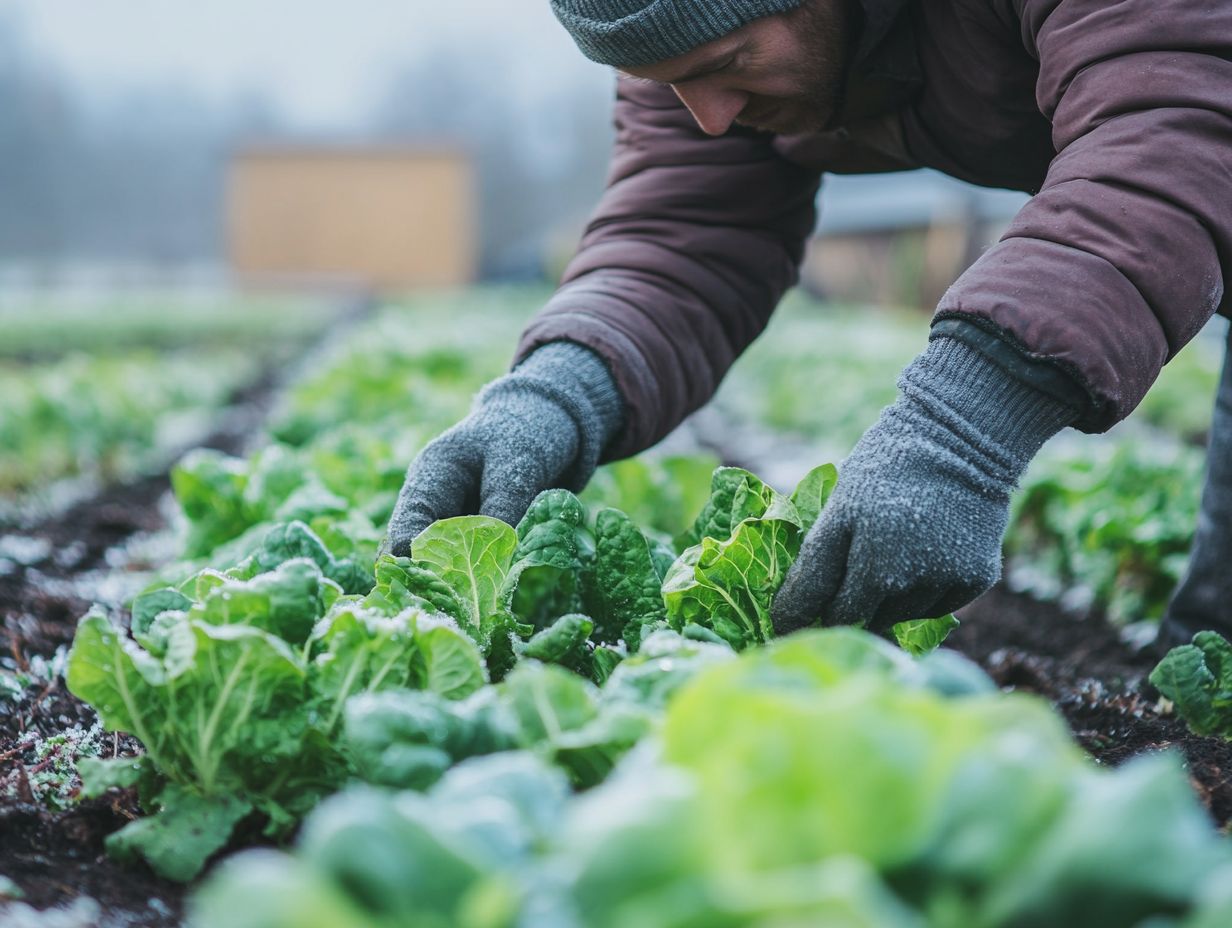
- Choose cold-hardy lettuce varieties, such as looseleaf lettuces, for successful growth in chilly temperatures.
- Prepare the soil by ensuring proper composition, moisture levels, and temperature for optimal growth.
- Protect your lettuce from frost and other cold weather threats by implementing covering and insulating methods, such as cold frames and hoop tunnels.
Why Grow Lettuce in Cold Conditions?
Growing lettuce in cold conditions presents a wealth of advantages. It enables you to extend your gardening seasons and savor fresh salad greens throughout the year, especially with the essential guide to gardening in cold weather, which highlights seed varieties adapted for cooler temperatures.
By selecting the right varieties like Winter Density, Paris Island, and Brune d Hiver, you can thrive even as the first frost draws near. These cold-resistant plants, such as Romaine lettuce and Larry’s Red Leaf, excel in conditions that many other crops shy away from. They are an exceptional choice for navigating the late summer heat as you transition into fall and winter gardening.
Choosing the Right Lettuce Varieties
Choosing the right lettuce varieties, such as Nevada and Dark Red Lollo Rossa, is essential for thriving in cold weather gardening. Different types showcase varying degrees of frost resistance, including bitter leaves and growth habits, so it’s wise to consider your options carefully.
Varieties such as Buttercrunch, Romaine, and Merlot are not just beloved for their delightful, crisp textures; they also flourish in cooler temperatures, making them outstanding selections for your garden beds.
Understanding the specifics of seed varieties and their unique requirements can significantly elevate your lettuce harvest, ensuring a generous supply of baby greens and various lettuce types throughout the chillier months.
Types of Lettuce that Thrive in Cold Weather
Certain types of lettuce, like Arctic King and Winter Wonderland, are your go-to allies for thriving in cold weather. Additionally, if you’re interested in expanding your garden, learning how to grow spinach in cold weather can also enhance your late fall and winter gardening.
Varieties like Arctic King, Winter Marvel, Rouge d’Hiver, and Red Leaf Lettuce bring diverse textures and flavors to the table that will elevate your salads. The standout qualities of varieties like Merlot and North Pole make them not only delicious but also visually appealing in your vegetable garden.
These hardy lettuce types can handle cold weather and varying moisture levels, allowing you to enjoy a steady crop even in challenging conditions, especially with organic fertilizers. Their adaptability means they can brave frost, ensuring your salads retain freshness and vibrancy that can enhance any meal.
The unique flavors and colors of seasonal vegetables will add variety to your winter salad spread, transforming each dish into a feast for the eyes as well as the palate. By incorporating these selections, including fall planting, you ll diversify your culinary repertoire and explore new textures and tastes during the colder months.
Start your cold-weather lettuce garden today and enjoy fresh greens all winter long!
Preparing the Soil for Cold Weather Lettuce

Preparing the soil for cold weather lettuce is a crucial step in securing a successful harvest. The right conditions can profoundly impact both growth and quality, especially with proper soil management techniques. To achieve optimal soil health, pay attention to factors such as moisture levels, temperature extremes, and the application of organic fertilizers that create nutrient-rich environments.
By incorporating practices like crop rotation, utilizing garden containers, and planting seeds in seed starters, you can elevate soil quality and foster sustainability in your gardening endeavors.
Soil Composition and Temperature Considerations
Understanding soil composition and temperature considerations is essential for cultivating healthy lettuce plants, particularly in cooler weather, which can be greatly influenced by your garden’s layout. The ideal soil should be well-draining, rich in organic matter, and capable of retaining sufficient moisture. It should also provide the necessary nutrients for optimal growth. Adding natural additives like compost can further enhance these qualities.
By monitoring temperature extremes and fine-tuning your soil management techniques, you can shield young seedlings from stress during fluctuating weather conditions, especially in home gardening scenarios.
Aim for a balanced blend of sand, silt, and clay, typically targeting a loamy texture that fosters aeration and root development for your lettuce plants. Sand enhances drainage, silt retains moisture and nutrients, while clay contributes to overall soil structure, which is crucial for successful lettuce growth.
Incorporating organic amendments like compost or well-rotted manure can enrich the soil, boost its moisture retention, and support beneficial microbes.
Maintaining an appropriate temperature range is crucial. Mulching serves to insulate the soil, reducing temperature fluctuations and minimizing erosion, especially during fall planting.
Together, these strategies create a robust environment where lettuce can thrive, ultimately leading to a healthy crop and a fruitful lettuce gardening experience, even in the face of environmental challenges.
Planting and Caring for Lettuce in Cold Weather
When you re planting and caring for lettuce in cold weather, the decision between direct sowing seeds and transplanting seedlings can greatly influence the success of your crop. Direct sowing is often preferred for its simplicity and speed, particularly with baby greens, while transplanting helps by providing earlier starts and more controlled growth conditions in your garden beds.
Regardless of the method you choose, grasping the optimal planting times, including fall planting, and mastering proper lettuce care techniques is essential for nurturing healthy plants that flourish in cooler temperatures.
Planting Techniques and Maintenance Tips
Employing effective planting techniques, like succession planting, and maintenance strategies can significantly elevate your lettuce gardening success during the colder months. For those interested in expanding their garden, checking out top tips for growing kale in cold climates can be highly beneficial. Practices like succession planting ensure you enjoy a continuous supply of fresh salad greens, while using organic fertilizers promotes vigorous growth and optimal nutrient uptake.
By closely monitoring outdoor gardening conditions and adjusting your approaches as needed, you can cultivate an ideal environment for your lettuce plants and minimize pest issues.
Understanding the importance of timing is essential; sowing planting seeds too early might expose them to frost, while planting too late could stifle growth. Pay attention to proper spacing to enhance air circulation, which reduces disease risks and promotes healthy lettuce growth.
Covering young plants with protective materials like row covers or cloches, and utilizing shade cloth, can offer insulation against the chill. Regular maintenance, including consistent watering and diligent pest management, will further support your plants health.
Using shade cloth on particularly sunny days helps shield tender leaves from wilting, allowing your lettuce crop to thrive even in challenging climatic conditions, especially during home gardening efforts.
Don t wait to get started on your lettuce garden! Start your cold weather lettuce garden today for a fresh harvest!
Protecting Lettuce from Frost and Other Cold Weather Threats
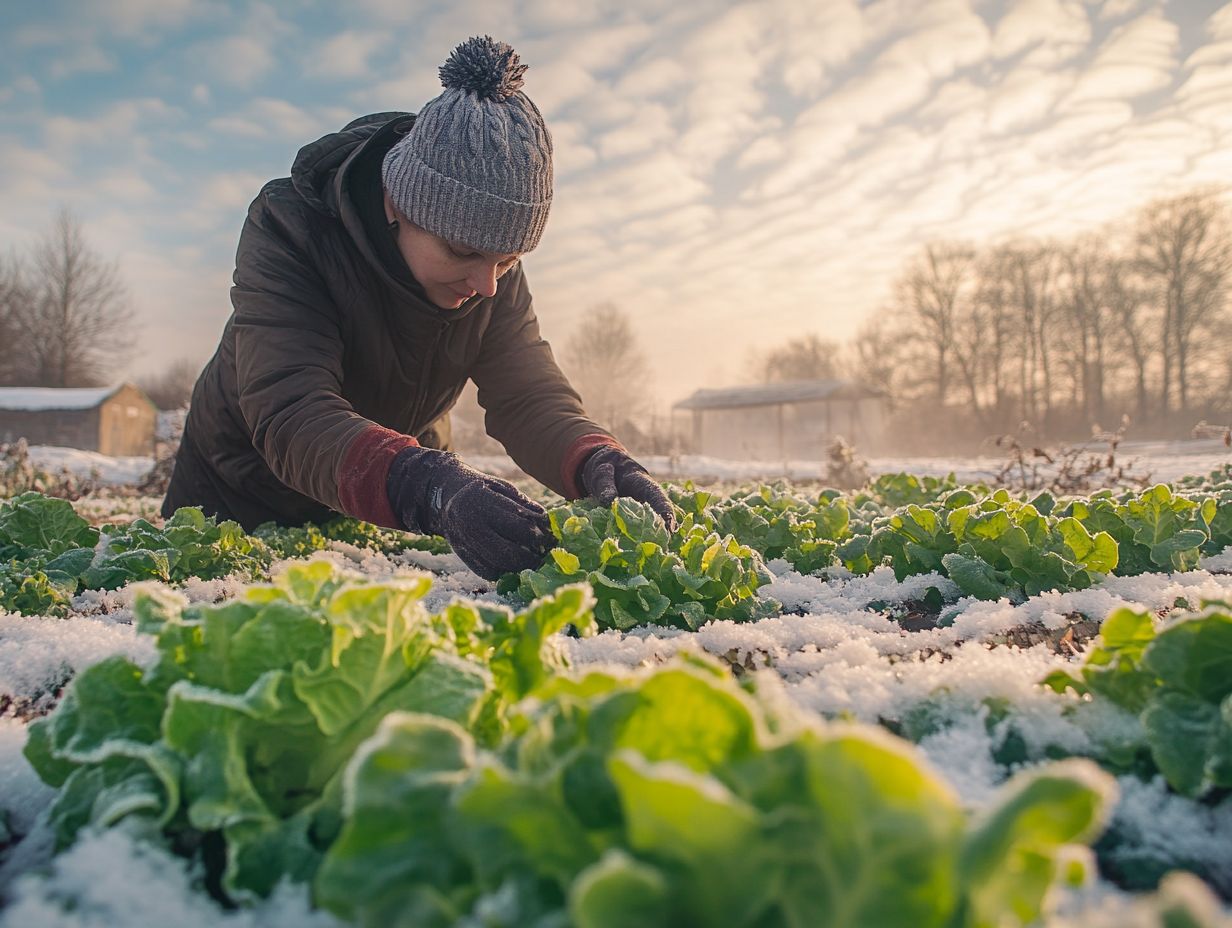
Protecting your lettuce, including **Romaine lettuce** and other varieties, from frost and other cold weather threats is crucial for securing a bountiful harvest during the chillier months. Use frost protection techniques such as cold frames, which are small greenhouses, and hoop tunnels. These create a nurturing microclimate for your lettuce.
Mastering the art of properly covering and insulating your lettuce beds will reduce frost damage and address any pest challenges that may arise as temperatures dip, ensuring your **garden containers** remain safe.
Covering and Insulating Methods
Covering and insulating methods are essential for protecting your lettuce crops, including **fall lettuce**, from frost and extreme cold. To learn more about this, check out our tips for growing microgreens in winter. Create a protective barrier with row covers or frost blankets. This maintains a warmer microclimate for your lettuce plants and enhances **lettuce growth**.
Enhance your **garden structure** with insulating materials to shield your plants against temperature fluctuations. This ensures healthier growth even in winter gardening conditions.
Utilizing materials such as floating row covers effectively traps heat while allowing sunlight and moisture to penetrate. This promotes photosynthesis and growth, which is vital for **growing lettuce**. For added insulation, arrange components like old blankets, **shade cloth**, or rigid foam panels around the edges of your garden beds. This helps retain warmth and mitigates the impact of harsh winds, protecting your **outdoor crops**.
Opting for specific lettuce varieties that are hardy and resilient, such as **Black-Seeded Simpson** and **Winter Wonderland**, can significantly optimize your gardening success. These techniques enhance the overall health of your crops and improve yields. Enjoy a **bountiful harvest** this season, even in challenging weather conditions, especially during **seasonal gardening**.
Harvesting and Storing Cold Weather Lettuce
Harvesting and storing cold weather lettuce involves specific best practices essential for maintaining both freshness and flavor in organic gardening and **home gardening** contexts. Understanding the right moment to harvest **lettuce types** is crucial, as timing significantly influences taste and texture.
Generally, pick your lettuce early in the morning for optimal quality. After harvesting, store your lettuce immediately in breathable bags to retain freshness. Utilizing appropriate storage techniques can prolong the lifespan of your greens while ensuring their crispness and nutritional value remain intact.
Best Practices for Harvesting and Storing Lettuce
Employing best practices for harvesting and storing lettuce is essential for enjoying fresh greens throughout the cold months. Harvest during cooler conditions, ideally early in the day, to maintain the crispness and flavor of your lettuce.
Once harvested, use proper storage techniques like breathable bags and moisture control to prolong the freshness of your organic lettuce, allowing you to savor your garden’s bounty for weeks.
Additionally, minimize stress on the lettuce plants during harvesting to preserve quality. Use gentle handling techniques, such as cutting instead of pulling, to prevent bruising and damage.
Store your lettuce at an ideal temperature between 32 F and 36 F to slow down deterioration significantly. Keeping humidity levels around 95% will prevent wilting, while good airflow helps avoid mold.
By following these guidelines, you ll keep your lettuce vibrant and enhance its flavor profile, making each bite a delightful experience.
Frequently Asked Questions
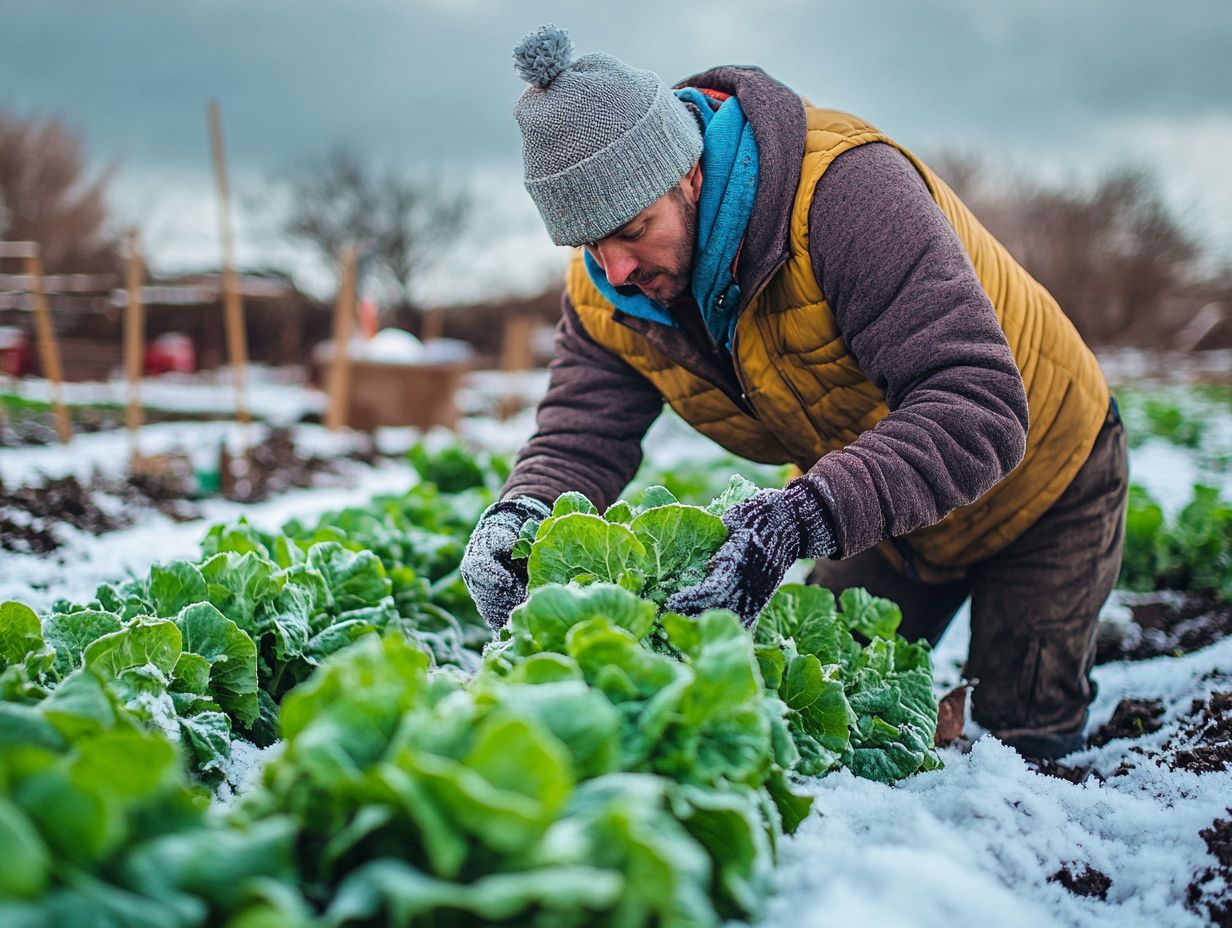
1. What are the best conditions for growing lettuce in cold weather?
Lettuce thrives in cool temperatures! Aim for a range of 45-65 F for the best growth. It can tolerate a few light frosts, but extended periods of below-freezing temperatures can damage the plants.
Try these techniques in your garden to ensure a thriving lettuce crop!
2. What type of lettuce is best for growing in cold conditions?
Crisphead, butterhead, and romaine are ideal for colder climates. These types can survive lower temperatures better than leafy varieties.
3. How do I prepare my soil for growing lettuce in cold conditions?
Before planting, mix in compost or well-aged manure. This will add nutrients and improve drainage.
Avoid compacting the soil, as it can hinder root growth and water absorption.
4. Can I grow lettuce in containers in cold weather?
Yes! Lettuce can thrive in containers even during cold weather! Use a well-draining potting mix and provide protection to prevent frost damage.
5. How often should I water my lettuce plants in cold weather?
Lettuce needs consistent moisture but should not be overwatered. Water them deeply 1-2 times per week, depending on rainfall. Don’t let your plants dry out completely!
6. Are there any tips for protecting my lettuce plants from cold weather?
Add a layer of mulch around the base to insulate the soil and prevent frost damage. You can also cover the plants with lightweight fabric or a cloche for extra protection!


